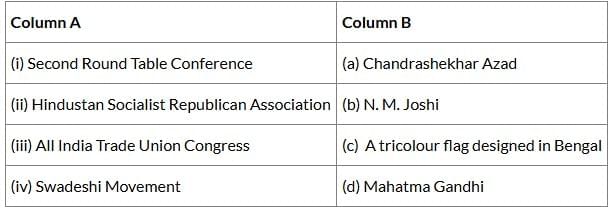Assertion & Reason Test: Nationalism in India - Class 10 MCQ
10 Questions MCQ Test - Assertion & Reason Test: Nationalism in India
Assertion: In 1918, Gandhiji organised a satyagraha to support the peasants of the Kheda district of Gujarat.
Reason: The peasants were affected by crop failure and plague epidemic. They could not pay the revenue and were demanding that revenue collection be relaxed.
Reason: The peasants were affected by crop failure and plague epidemic. They could not pay the revenue and were demanding that revenue collection be relaxed.
Direction: Mark the Option Which Is Most Suitable:
Assertion : The Non-Cooperation Movement gradually slowed down for a variety of reasons in the cities.
Reason : As the boycott movement spread, and people began discarding imported clothes and wearing only Indian ones, production of Indian textile mills and handlooms went up.
Direction: Mark the Option Which Is Most Suitable:
Assertion : When Simon Commission arrived in India, it was greeted with the slogan ‘Go back Simon’.
Reason : This happened as Mahatma Gandhi was on Dandi March during that time.
Direction: Mark the Option Which Is Most Suitable:
Assertion : Rich peasants became enthusiastic supporters of the Civil Disobedience Movement, organising their communities and at times forcing reluctant members to participate in the boycott programmes.
Reason : However, they were deeply happy when the movement was called off in 1931 with revenue rates being lowered.
Which of the following options best represents the idea conveyed in the passage about the use of icons and symbols in the national movement?
As the national movement developed, nationalist leaders became more and more aware of such icons and symbols in unifying people and inspiring in them a feeling of nationalism. During the Swadeshi Movement in Bengal, a tricolour flag (red, green and yellow) was designed. It had eight lotuses representing eight provinces of British India, and a crescent moon, representing Hindus and Muslims. By 1921, Gandhiji had designed the Swaraj flag. It was again a tricolour (red, green and white) and had a spinning wheel in the centre, representing the Gandhian ideal of self-help. Carrying the flag, and holding it aloft, during marches became a symbol of defiance.
Arrange the following in the correct sequence: Certain events are given below.
Choose the appropriate chronological order:
(i) Formation of the Muslim League.
(ii) The First World War.
(iii) The first meeting of the Indian National Congress in Bombay.
(iv) The war prices increased in double.
Match the following items given in Column A with those in Column B:

In the questions given below, there are two statements marked as Assertion (A) and Reason (R). Read the statements and choose the correct option:
Assertion (A) : It was declared that 26th January, 1930 would be celebrated as the Independence Day when people were to take a pledge to struggle for Complete Independence.
Reason (R) : Mahatma Gandhi had to find a way to relate this abstract idea of freedom to more concrete issues of everyday life.














